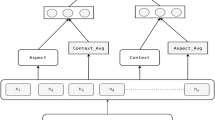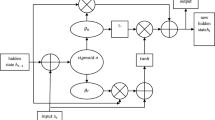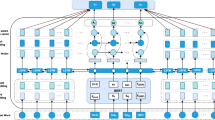Abstract
With the increase of unstructured text on social media platforms from user opinions, deep neural network techniques have significantly contributed to the aspect extraction subtask of Aspect-Based Sentiment Analysis (ABSA). In a multi-sentence review, sentences are contextually interdependent, and static word embedding generates similar representations for the same word in different domains. Hence, existing techniques cannot capture inter-sentence dependencies for valid multi-word aspect extraction. Further, incorporating conceptual information to associate the context and aspect terms is still a challenging task. Therefore, this paper aims to remove inadequate information and capture aspect co-referencing by adding a sentence coreference resolution step before performing ABSA in an unsupervised rule-based method. Next, domain irrelevant aspects are pruned out using contextual embedding. Furthermore, aspects extracted using unsupervised way are given as labeled in training the hierarchical attention-based network using pre-trained language model BERT, Bidirectional Encoder Representations from Transformers. The experimental results on the SemEval-16 dataset show that F-score results are between 2.5% and 5% better than recent supervised deep learning approaches for laptop and restaurant domains, respectively.








Similar content being viewed by others
References
Akhtar S, Garg T, Ekbal A (2020) Neurocomputing multi-task learning for aspect term extraction and aspect sentiment classification. Neurocomputing 398:247–256. https://doi.org/10.1016/j.neucom.2020.02.093
Ba JL, Kiros JR, Hinton GE (2016) Layer normalization
Blair-Goldensohn S, Hannan K, McDonald R et al (2008) Building a sentiment summarizer for local service reviews. WWW Work NLP Inf Explos Era:339–348
Chauhan GS, Kumar Meena Y (2018) Prominent aspect term extraction in aspect based sentiment analysis. In: 3rd international conference and workshops on recent advances and innovations in engineering, ICRAIE 2018. Institute of Electrical and Electronics Engineers Inc, pp 1–6. https://doi.org/10.1109/ICRAIE.2018.8710408
Chauhan GS, Meena YK (2019) YouTube video ranking by aspect-based sentiment analysis on user feedback. In: Advances in intelligent systems and computing. Springer Verlag, pp 63–71, vol 900. Springer, Singapore. https://doi.org/10.1007/978-981-13-3600-3_6
Chauhan GS, Agrawal P, Meena YK (2019) Aspect-based sentiment analysis of students’ feedback to improve teaching–learning process. In: Smart innovation, Systems and Technologies. Springer Science and Business Media Deutschland GmbH, pp 259–266, vol 107. Springer, Singapore. https://doi.org/10.1007/978-981-13-1747-7_25
Chen T, Xu R, He Y, Wang X (2017) Improving sentiment analysis via sentence type classification using BiLSTM-CRF and CNN. Expert Syst Appl 72:221–230. https://doi.org/10.1016/j.eswa.2016.10.065
Devlin J, Chang MW, Lee K, Toutanova K (2019) BERT: Pre-training of deep bidirectional transformers for language understanding. NAACL HLT 2019–2019 Conf North Am Chapter Assoc Comput Linguist Hum Lang Technol - Proc Conf 1:4171–4186
Dilawar N, Majeed H Sentence Vector Representation Methods for Aspect Category Detection. 1–10
Do HH, Prasad PWC, Maag A, Alsadoon A (2019) Deep learning for aspect-based sentiment analysis: a comparative review. Expert Syst Appl 118:272–299. https://doi.org/10.1016/j.eswa.2018.10.003
Fan GF, Yu M, Dong SQ, Yeh YH, Hong WC (2021) Forecasting short-term electricity load using hybrid support vector regression with grey catastrophe and random forest modeling. Util Policy 73:101294. https://doi.org/10.1016/j.jup.2021.101294
Hoang M, Rouces J (2019) Aspect-based sentiment analysis using BERT
Hu M, Liu B (2004) Mining and summarizing customer reviews. In: KDD-2004 - proceedings of the tenth ACM SIGKDD international conference on knowledge discovery and data mining. ACM Press, New York, pp 168–177
Jebbara S, Cimiano P (2016) Aspect-based sentiment analysis using a two-step neural network architecture. In: Communications in computer and information science. Springer Verlag, 641, pp 153–167. https://doi.org/10.1007/s10994-013-5413-0
Kang Y, Zhou L (2017) RubE: rule-based methods for extracting product features from online consumer reviews. Inf Manag 54:166–176. https://doi.org/10.1016/j.im.2016.05.007
Kersting JGM (2021) Human language comprehension in aspect phrase extraction with importance weighting. Nat Lang Process Inf Syst 12801:231–242. https://doi.org/10.1007/978-3-030-80599-9_21
Li X, Lam W (2017) Deep multi-task learning for aspect term extraction with memory interaction, EMNLP. Association for Computational Linguistics, pp 2886–2892. https://doi.org/10.18653/v1/D17-1310
Li S, Zhou L, Li Y (2015) Improving aspect extraction by augmenting a frequency-based method with web-based similarity measures. Inf Process Manag 51(1):58–67. https://doi.org/10.1016/j.ipm.2014.08.005
Li X, Bing L, Zhang W, Lam W (2019) Exploiting BERT for end-to-end aspect-based sentiment analysis. 34–41. https://doi.org/10.18653/v1/d19-5505
Liu B, Hsu W, Ma Y (1998) Integrating classification and association rule mining
Liu P, Joty S, Meng H (2015) Fine-grained opinion mining with recurrent neural networks and word Embeddings. Association for Computational Linguistics
Liu MZ, Zhou FY, Chen K, Zhao Y (2021) Co-attention networks based on aspect and context for aspect-level sentiment analysis. Knowledge-Based Syst 217:106810. https://doi.org/10.1016/j.knosys.2021.106810
Ma D, Li S, Zhang X, Wang H (2017) Interactive attention networks for aspect-level sentiment classification, IJCAI, Artificial Intelligence (cs.AI); Computation and Language (cs.CL). https://doi.org/10.48550/arXiv.1709.00893
Meškelė D, Frasincar F (2020) ALDONAr: a hybrid solution for sentence-level aspect-based sentiment analysis using a lexicalized domain ontology and a regularized neural attention model. Inf Process Manag 57(3):102211. https://doi.org/10.1016/j.ipm.2020.102211
Mikolov T, Chen K, Corrado G, Dean J (2013) Efficient estimation of word representations in vector space. In: 1st international conference on learning representations, ICLR 2013 - workshop track proceedings. International conference on learning representations, ICLR
Ozyurt B, Akcayol MA (2021) A new topic modeling based approach for aspect extraction in aspect based sentiment analysis: SS-LDA. Expert Syst Appl 168:114231. https://doi.org/10.1016/j.eswa.2020.114231
Peng C, Zhongqian S, Lidong B, Yang W (n.d.) Recurrent Attention Network on Memory for Aspect Sentiment Analysis
Peters ME, Neumann M, Iyyer M et al (2018) Improving language understanding by. OpenAI:1–10
Pontiki M, Galanis D, Papageorgiou H, et al (n.d.) SemEval-2016 Task 5: Aspect Based Sentiment Analysis
Popescu AM, Etzioni O (2005) Extracting product features and opinions from reviews. In: HLT/EMNLP 2005 - human language technology conference and conference on empirical methods in natural language processing. Proceedings of the Conference. Association for Computational Linguistics, Morristown, pp 339–346. https://aclanthology.org/H05-1043
Poria S, Cambria E, Gelbukh A (2016) Aspect extraction for opinion mining with a deep convolutional neural network. Knowledge-Based Syst 108:42–49. https://doi.org/10.1016/j.knosys.2016.06.009
Qiu G, Liu B, Bu J, Chen C (2011) Opinion word expansion and target extraction through double propagation
Radford A, Wu J, Child R, et al (2018) Language models are unsupervised multitask learners
Rajput R, Solanki A (2016) International journal of computer science and Mobile computing review of sentimental analysis methods using lexicon based approach. Int J Comput Sci Mob Comput 5:159–166
Rajput R, Solanki A (2017) Real time sentiment analysis of tweets using machine learning and semantic analysis. Commun Comput Syst - Proc Int Conf Commun Comput Syst ICCCS 2016:687–692. https://doi.org/10.1201/9781315364094-123
Rana TA, Cheah YN (2016) Aspect extraction in sentiment analysis: comparative analysis and survey. Artif Intell Rev 46:459–483. https://doi.org/10.1007/s10462-016-9472-z
Rana TA, Cheah YN (2017) A two-fold rule-based model for aspect extraction. Expert Syst Appl 89:273–285. https://doi.org/10.1016/j.eswa.2017.07.047
Rana TA, Cheah YN, Letchmunan S (2016) Topic modeling in sentiment analysis: a systematic review. J ICT Res Appl 10:76–93
Ravi K, Ravi V (2015) A survey on opinion mining and sentiment analysis: tasks, approaches and applications. Knowledge-Based Syst 89:14–46. https://doi.org/10.1016/j.knosys.2015.06.015
Ren Z, Shen Q, Diao X, Xu H (2021) A sentiment-aware deep learning approach for personality detection from text. Inf Process Manag 58:102532. https://doi.org/10.1016/j.ipm.2021.102532
Rojas-Barahona LM (2016) Deep learning for sentiment analysis. Lang Linguist Compass 10:701–719. https://doi.org/10.1111/lnc3.12228
Ruder S, Ghaffari P, Breslin JG (n.d.) A Hierarchical Model of Reviews for Aspect-based Sentiment Analysis
Samha AK, Li Y, Zhang J (2015) Aspect-based opinion mining from product reviews using conditional random fields. Undefined
Schouten K, Frasincar F (2016) Survey on aspect-level sentiment analysis. IEEE Trans Knowl Data Eng 28:813–830. https://doi.org/10.1109/TKDE.2015.2485209
Schouten K, van der Weijde O, Frasincar F, Dekker R (2017) Supervised and unsupervised aspect category detection for sentiment analysis with co-occurrence data. IEEE Trans Cybern 48:1263–1275. https://doi.org/10.1109/TCYB.2017.2688801
Singh Chauhan G, Kumar Meena Y, Gopalani D, Nahta R (2020) A two-step hybrid unsupervised model with attention mechanism for aspect extraction Expert Syst Appl 113673. https://doi.org/10.1016/j.eswa.2020.113673
Singh Chauhan G, Kumar Meena Y, Gopalani D, Nahta R (2020) A two-step hybrid unsupervised model with attention mechanism for aspect extraction. Expert Syst Appl 161:113673. https://doi.org/10.1016/j.eswa.2020.113673
Singh T, Nayyar A, Solanki A (2020) Multilingual opinion mining movie recommendation system using RNN. Springer, Singapore
Srividya K, Mary Sowjanya A (2021) NA-DLSTM – a neural attention based model for context aware aspect-based sentiment analysis. Mater Today Proc https://doi.org/10.1016/j.matpr.2021.01.782
Su J, Tang J, Jiang H, Lu Z, Ge Y, Song L, Xiong D, Sun L, Luo J (2021) Enhanced aspect-based sentiment analysis models with progressive self-supervised attention learning. Artif Intell 296:103477. https://doi.org/10.1016/j.artint.2021.103477
Sun C, Huang L, Qiu X (2019) Utilizing BERT for aspect-based sentiment analysis via constructing auxiliary sentence. NAACL HLT 2019–2019 Conf North Am Chapter Assoc Comput Linguist Hum Lang Technol - Proc Conf 1:380–385
Tan X, Cai Y, Xu J, Leung HF, Chen W, Li Q (2020) Improving aspect-based sentiment analysis via aligning aspect embedding. Neurocomputing 383:336–347. https://doi.org/10.1016/j.neucom.2019.12.035
Tay Y, Anh Tuan L, Cheung Hui S (2017) Dyadic memory networks for aspect-based sentiment analysis. https://doi.org/10.1145/3132847.3132936
Toh Z, Su J (2016) NLANGP at SemEval-2016 task 5: improving aspect based sentiment analysis using neural network features
Vaswani A, Shazeer N, Parmar N, et al (2017) Attention is all you need. Adv Neural Inf Process Syst 2017-Decem:5999–6009
Wang X, Li F, Zhang Z, Xu G, Zhang J, Sun X (2021) A unified position-aware convolutional neural network for aspect based sentiment analysis. Neurocomputing. 450:91–103. https://doi.org/10.1016/j.neucom.2021.03.092
Wang X, Xu G, Zhang Z, Jin L, Sun X (2021) End-to-end aspect-based sentiment analysis with hierarchical multi-task learning. Neurocomputing. 455:178–188. https://doi.org/10.1016/j.neucom.2021.03.100
Wu C, Wu F, Wu S, Yuan Z, Huang Y (2018) A hybrid unsupervised method for aspect term and opinion target extraction. Knowledge-Based Syst 148:66–73. https://doi.org/10.1016/j.knosys.2018.01.019
Wu C, Xiong Q, Yang Z, Gao M, Li Q, Yu Y, Wang K, Zhu Q (2021) Residual attention and other aspects module for aspect-based sentiment analysis. Neurocomputing 435:42–52. https://doi.org/10.1016/j.neucom.2021.01.019
Yang B, Cardie C (2012) Extracting opinion expressions with semi-Markov conditional random fields. Association for Computational Linguistics
Yang C, Zhang H, Jiang B, Li K (2019) Aspect-based sentiment analysis with alternating coattention networks. Inf Process Manag 56:463–478. https://doi.org/10.1016/j.ipm.2018.12.004
Yuan Z, Wu S, Wu F, Liu J, Huang Y (2018) Domain attention model for multi-domain sentiment classification. Knowledge-Based Syst 155:1–10. https://doi.org/10.1016/j.knosys.2018.05.004
Author information
Authors and Affiliations
Corresponding author
Ethics declarations
Conflict of interest
The authors confirm no conflict of interest with the submission and ensure that the manuscript has not been published nor under consideration else.
Additional information
Publisher’s note
Springer Nature remains neutral with regard to jurisdictional claims in published maps and institutional affiliations.
Rights and permissions
About this article
Cite this article
Chauhan, G.S., Meena, Y.K., Gopalani, D. et al. A mixed unsupervised method for aspect extraction using BERT. Multimed Tools Appl 81, 31881–31906 (2022). https://doi.org/10.1007/s11042-022-13023-7
Received:
Revised:
Accepted:
Published:
Issue Date:
DOI: https://doi.org/10.1007/s11042-022-13023-7




